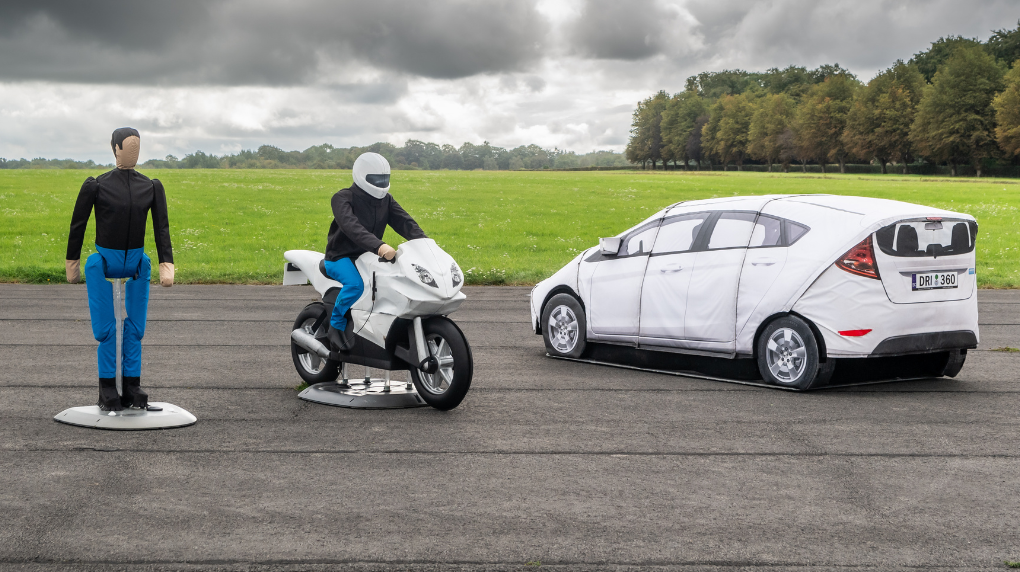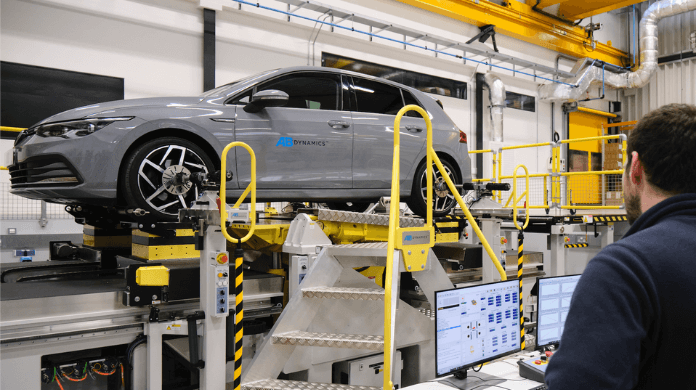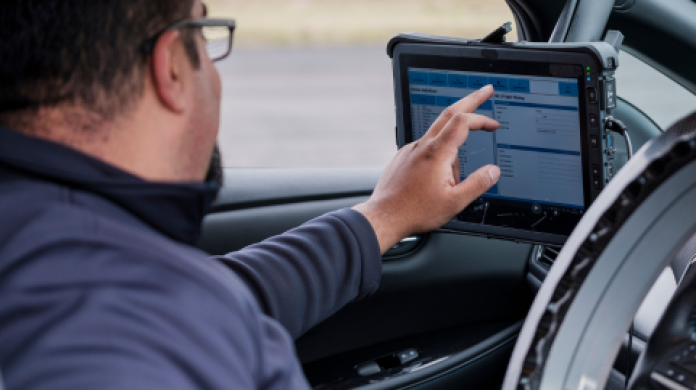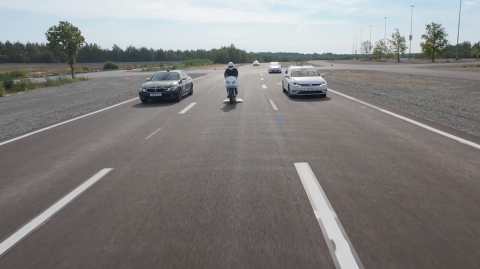Over the past decade, the Advanced Driver Assistance Systems (ADAS) market has undergone a rapid transformation. In 2015, 45% of newly registered vehicles worldwide had zero ADAS functionality, in 2025 this is expected to be just 6%. Vehicles have become increasingly equipped with sophisticated technologies to enhance safety and improve the driving experience, and as a result, the demand for robust and realistic testing methods has surged.

We sat down with Jordan Silberling, General Manager at DRI, AB Dynamics’ California-based sister company and a leading test consultancy specialising in K&C testing, human factors research, ADAS testing and target design. Jordan has been at the forefront of ADAS target development for more than 10 years and helped to create the Soft Car 360, a product that has become synonymous with ADAS testing. Our conversation delves into the challenges of keeping pace with the swift developments in the testing market and highlighting the crucial role realism, robustness and cost-effectiveness plays in creating a successful ADAS target.
Why does the automotive sector need next-gen ADAS targets?
Firstly, as a response to the volume and complexity of ADAS tests, the ADAS market continues to change rapidly. There is a strong desire across the industry to improve vehicle safety and it is clear that advancements in technology are a key enabler to having more effective active safety systems. Vehicles are increasingly being equipped with more sophisticated equipment. They are better than ever at identifying and classifying objects in their environment enabling them to make more informed decisions earlier, which is key to improving safety. As a result, regulatory bodies and consumer bodies are increasing the complexity of tests to challenge these new technologies to continue to drive improved safety. On top of this, vehicle manufacturers want to ensure their systems not only satisfy the testing requirements but also work effectively in the real world too.
Secondly, as an independent test consultancy carrying out hundreds of ADAS tests a year for customers, we experienced first-hand why a new generation of ADAS targets was required. Before we developed our own products, we had to use what was commercially available in the market and we became frustrated with the lack of realism and the damage caused to test vehicles, which was not only costly but also delayed our test programs.
What are your key considerations when designing an ADAS target?
The target must conform to industry standards that dictate particular design elements, such as the dimensions or sensor recognition characteristics. This ensures consistency between targets from different manufactures but restricts the extent of design changes that can be made. They also need to meet certain criteria to be approved for use in official regulatory and consumer testing, such as Euro NCAP.
However, standards conformance is the minimum requirement. Our top priority is to optimise the usability of the target. This ultimately boils down to making the products flexible, durable and cost-effective. We use hard-wearing materials to minimise damage to the target itself and a modular architecture to minimise cost should damage occur.
We also invest heavily in ensuring our targets are as realistic as possible within the constraints of meeting the various standards while not compromising usability. We collaborate with sensor suppliers to better understand how ADAS sensors ‘see’ the world. We also conduct thorough research to help improve the realism of our targets. For example, we have researched pedestrian gait, to ensure the motion of our dummies is representative of humans at a range of speeds. We also commercialised our own specialised scanner device to take radar and lidar measurements of our targets to compare and fine tune them to mimic the signature of the actual objects. It also enables our customers to periodically check that their targets are in conformance with standards.
What about minimising the cost of ADAS testing?
The initial investment in a premium ADAS target might be slightly higher, but the long-term benefits outweigh the costs. Downtime during testing sessions due to target damage or test vehicle damage is a significant factor in overall testing expenses. The last thing you want is your test engineers standing around wasting track time while repairs are being made. As a contracted provider of ADAS testing for the NHTSA (National Highway Traffic Safety Administration), we know this from experience.
As a result, not only do our targets focus on realism but we also prioritise the usability and durability to reduce downtime. Features like interchangeable limbs for pedestrian dummies and ensuring all hard points are minimised contribute to ease of use and minimal disruption during testing, ultimately saving valuable time and resources.
In your opinion, how important are realistic targets?
The primary goal of ADAS testing for most manufacturers is essentially to acquire as much high-quality data as possible. The quality of this data is directly linked to the accuracy of the targets used, which is why DRI’s product development focuses on optimising realism. Compromising on the realism of your ADAS target will result in inaccurate test data. Investing in premium targets ensures not just compliance but provides confidence in the data generated and improves the cost-effectiveness of testing.
Additionally, consider that initial pedestrian ADAS testing required only a static target. Later, dynamic testing was introduced into the regulatory and consumer testing but but currently only articulation of the legs is required. Clearly, this is not fully representative of a human’s gait and could impact the way the vehicle classifies the pedestrian, or indeed the pedestrian’s intent. As a result, I believe articulation of the arms and the head will be a requirement in the near future.
Our Soft Pedestrian 360 target features sophisticated articulation of the knee, hip, shoulder and neck. This provides more control over the gait and allows a greater range of movement than is currently required by regulatory and consumer testing requirements. By making our products as realistic as possible we significantly extend their usability and lifespan.
What role does AB Dynamics play in the development of DRI’s ADAS targets?
A realistic ADAS target is part of the complete test environment required for effective testing. We design targets with the AB Dynamics propulsion system in mind and vice-versa. For example, our Soft Pedestrian 360 and AB Dynamics’ LaunchPad Spin together enable matched motion and speed between the dummy’s legs and the platform’s speed. There are other design criteria to consider too, such as ensuring the targets can match the speed capabilities of the platforms and how the combination of products impacts the radar signature. Ultimately, our combined solution ensures that the dummy motion can be integrated into the heart of the scenario, simplifying setup, and guaranteeing realism.
What industry trends are shaping the future development of ADAS targets?
Intent will be key going forward. That is, systems will begin trying to determine the intent of a pedestrian, for example, by reading the person's body language. This is something we do as humans instinctively. If you see somebody stopped at the roadside looking both ways you know they intend to cross the road and you can adjust your driving as a result. AI-trained systems and real-time image and video processing are learning to look for these cues. As the industry evolves, the integration of vision software becomes crucial in classifying and tracking objects. Pedestrian targets will need to be able to mimic these behaviours to thoroughly test these systems.
We achieve this in the Soft Pedestrian 360 through sophisticated limb articulation and its modular architecture, which enables the standard arm to be switched with an arm holding a mobile phone, for example. The LaunchPad Spin, the platform that the target is moved by, provides turn-on-the-spot mobility to replicate sudden changes in direction or intent.
Key Takeaways:
- Rapid evolution of ADAS market: The ADAS market has transformed rapidly, with a significant growth in vehicles equipped with increasingly advanced ADAS functionality. This is driving a surge in demand for more sophisticated and realistic ADAS targets.
- Importance of realism in ADAS testing: DRI emphasises the pivotal role of realism in ADAS testing. Premium ADAS targets, such as the Soft Pedestrian 360, offer sophisticated articulation to ensure a realistic testing environment and future-proof testing.
- Making testing more cost-effective: Prioritising usability and durability minimises downtime during testing, saving valuable time and resources.
- Emerging trends in ADAS testing: DRI anticipates a shift towards a focus on interpreting human intent in ADAS testing. ADAS targets must emulate these behaviours to effectively test and validate image and video processing systems.
For more information on DRI’s market leading ADAS targets, visit their website here or watch AB Dynamics’ latest webinar “A complete solution for NCAP motorcycle scenario testing”, where Jordan Silberling provides insights into DRI’s Soft Motorcycle 360 target.











